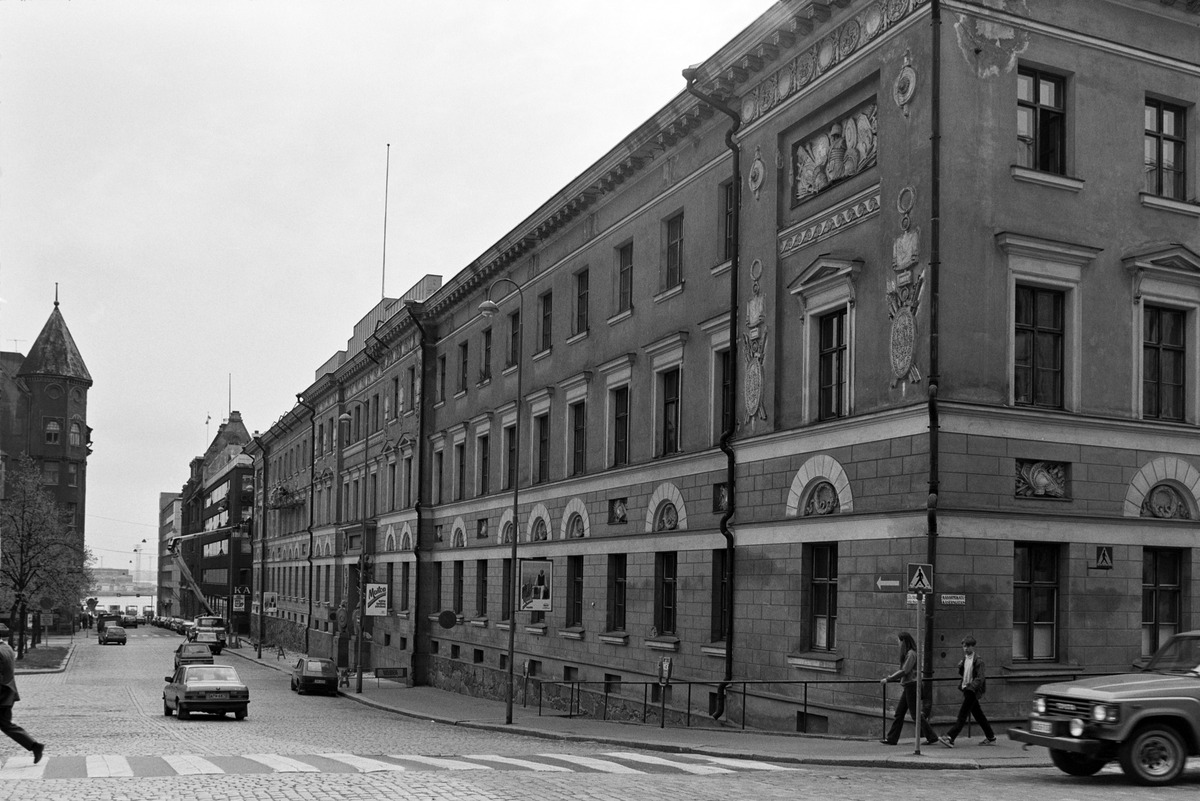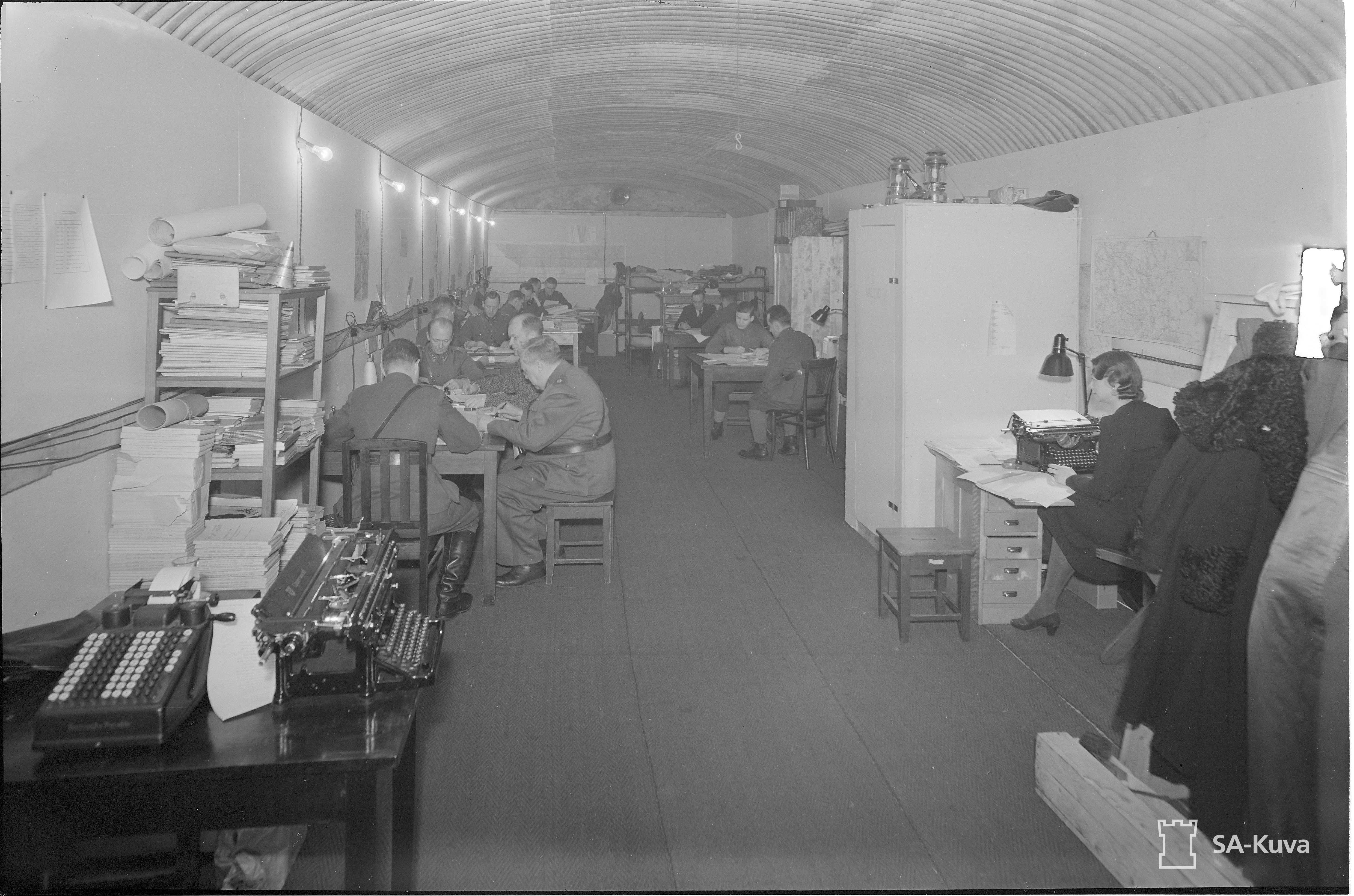Excerpts from the History of the Ministry of Defence

With the decree issued on 14 June 1918, the War Department was established in the Financial Division of Finland's Senate. Still today, 14 June is the anniversary of the Ministry of Defence. In November 1918, the Senate became the Council of State and the War Department became the War Ministry. On the basis of the so-called Act on ministries, adopted in 1922, the War Ministry was renamed as the Ministry of Defence. On 18 June 1918, the Foreign Affairs Department was established, too. Apart from military and foreign affairs, the administration of the autonomous Grand Duchy of Finland had been functioning well over 100 years and, consequently, there was no need to establish other new departments.
The first task of the Ministry of Defence was to start organising, training and equipping the armed forces. Professional skills had been acquired in the Czar's army in Russia and through jaeger training in Germany. In the early years, a number of officers were sent to military schools in different European countries.
The first chief of the War Department was major general Wilhelm Thesleff - the first defence minister. In the 1940's and 1950's, Emil Skog held office for 2623 days, which is the longest running term of office to date. The future president Kyösti Kallio acted as defence minister in 1923. Home Guard warrant officer Juho Niukkanen became known as the defence minister during the Winter War 1939-40. General of infantry Rudolf Walden who was also an industrialist was in office during the Continuation War 1941-44. A pacifist and defence minister, Yrjö Kallinen held office 1946-48 and started the tradition of organising the New Year Day's reception, which has become the second most appreciated event, the first one being the Independence Day reception given by the President of the Republic. In 1990, Elisabeth Rehn became the first woman defence minister.
The first permanent secretary at the ministry of defence was colonel Carl Emil Voss-Schrader. Lieutenant general Oiva Olenius was in office longest, from 1926 until 1955. The present permanent secretary Esa Pulkkinen is the 18th holder of the office. He was appointed permanent secretary in 2022.
The number of staff at the ministry of defence has greatly varied over the years. In 1918, there was 40 to 50 staff. During the Winter War the number of staff was as high as about 500, and between the Winter War and the Continuation War it was at its lowest, 28. The current number of staff is about 140.
In the course of history the Ministry of Defence has located in many different places. The first location was at Etelä-Esplanadi 10 which today houses the Ministry of Justice. In 1921, the Ministry of Defence moved to Korkeavuorenkatu 21, also called the Okhrana house. During the Winter War, the Ministry of Defence moved to underground premises in Seurasaarentie and to the villas in Meilahti. In addition, some of the functions were moved to Munkkiniemi, Hämeenlinna, Järvenpää and Kerava. After the Winter War, the Ministry of Defence resumed its original premises at Etelä-esplandi 10. From 1941 to 1956, the Ministry was housed at Snellmaninkatu 4-6, the current location of the Financial Supervision Authority. During the Continuation War, some of the functions were moved to Ruoholahti, Hauho and Lammi. In July 1956, the Ministry of Defence moved to the present location at Eteläinen Makasiinikatu 8 on the Barracks Square.

Designed by C. L. Engel, the building that the Ministry of Defence now occupies was constructed in 1822. It was part of the garrison area of Finland's Guard and housed the Guard headquarters, the officers' club and the officers' living quarters. The White Guard of Finland was housed in the building from 1918 to 1939. The building was destroyed in the major bombardment of Helsinki 26 to 27 February 1944; only the walls remained. In the post-war years, there was a lively debate about the fate of the ruins where willow herb was growing and the entire Guard quarters. Reconstruction was started in 1954 under architect Aulis Blomstedt and the work was completed in 1956.
Finnish Ministers of Defence
Ministers of Defence
| Häkkänen, Antti | 20.6.2023– |
| Kaikkonen, Antti | 28.2.2023–20.6.2023 |
| Savola, Mikko | 5.1.2023–28.2.2023 |
| Kaikkonen, Antti | 6.6.2019–4.1.2023 |
| Niinistö, Jussi | 29.5.2015–6.6.2019 |
| Haglund, Carl | 5.7.2012–29.5.2015 |
| Wallin, Stefan | 22.6.2011–29.6.2012 |
| Häkämies, Jyri | 19.4.2007–22.6.2011 |
| Kääriäinen, Seppo | 24.6.2003–19.4.2007 |
| Vanhanen, Matti | 17.4.2003–24.6.2003 |
| Enestam, Jan-Erik | 15.4.1999–17.4.2003 |
| Taina, Anneli | 13.4.1995–15.4.1999 |
| Enestam, Jan-Erik | 1.1.1995–13.4.1995 |
| Rehn, Elisabeth | 26.4.1991–31.12.1994 |
| Rehn, Elisabeth | 13.6.1990–26.4.1991 |
| Norrback, Ole | 30.4.1987–13.6.1990 |
| Pihlajamäki, Veikko | 6.5.1983–30.4.1987 |
| Saukkonen, Juhani | 19.2 1982–6.5.1983 |
| Äikäs, Lasse | 26.5.1979–19.2.1982 |
| Tähkämaa, Taisto | 15.5.1977–26.5.1979 |
| Westerlund, Seppo | 29.9.1976–15.5.1977 |
| Melin, Ingvar | 30.11.1975–29.9.1976 |
| Huurtamo, Erkki | 13.6.1975–30.11.1975 |
| Homén, Carl-Olof | 1.10.1974–13.6.1975 |
| Gestrin, Kristian | 4.9.1972–30.9.1974 |
| Hostila, Sulo | 23.2.1972–4.9.1972 |
| Pentti, Arvo | 29.10.1971–23.2.1972 |
| Gestrin, Kristian | 15.7.1970–29.10.1971 |
| Pentti, Arvo | 14.5.1970–15.7.1970 |
| Suorttanen, Sulo | 22.3.1968–14.5.1970 |
| Suorttanen, Sulo | 27.5.1966–22.3.1968 |
| Pentti, Arvo | 12.9.1964–27.5.1966 |
| Leinonen, Kaarlo | 18.12.1963–12.9.1964 |
| Pentti, Arvo | 13.4.1962–18.12.1963 |
| Björkenheim, Edvard | 14.7.1961–13.4.1962 |
| Häppölä, Leo | 13.1.1959–14.7.1961 |
| Wiherheimo, Toivo | 29.8.1958–13.1.1959 |
| Björkenheim, Edvard | 26.4.1958–29.8.1958 |
| Lehmus, Kalle | 29.11.1957–26.4.1958 |
| Malinen, Pekka | 2.9.1957–29.11.1957 |
| Pakkanen, Atte | 27.5.1957–2.9.1957 |
| Skog, Emil | 3.3.1956–27.5.1957 |
| Skog, Emil | 20.10.1954–3.3.1956 |
| Skog, Emil | 5.5.1954–20.10.1954 |
| Hetemäki, Päiviö | 17.11.1953–5.5.1954 |
| Kleemola, Kauno | 9.7.1953–17.11.1953 |
| Skog, Emil | 20.9.1951–9.7.1953 |
| Skog, Emil | 17.1.1951–20.9.1951 |
| Tiitu, Kustaa | 17.3.1950–17.1.1951 |
| Skog, Emil | 29.7.1948–17.3.1950 |
| Kallinen, Yrjö | 27.3.1946–29.7.1948 |
| Pekkala, Mauno | 27.3.1946–29.7.1948 |
| Pekkala, Mauno | 26.3.1946–27.3.1946 |
| Pekkala, Mauno | 17.4.1945–26.3.1946 |
| Valve, Väinö | 1.12.1944–17.4.1945 |
| Walden, Rudolf | 17.11.1944–1.12.1944 |
| Walden, Rudolf | 21.9.1944–17.11.1944 |
| Walden, Rudolf | 8.8.1944–21.9.1944 |
| Walden, Rudolf | 5.3.1943–8.8.1944 |
| Walden, Rudolf | 4.1.1941–5.3.1943 |
| Walden, Rudolf | 27.3.1940–4.1.1941 |
| Niukkanen, Juho | 1.12.1939–27.3.1940 |
| Niukkanen, Juho | 12.3.1937–1.12.1939 |
| Oksala, Arvi | 7.10.1936–12.3.1937 |
| Oksala, Arvi | 14.12.1932–7.10.1936 |
| Lahdensuo, Jalo | 21.3.1931–14.12.1932 |
| Manner, Albin | 10.7.1930–21.3.1931 |
| Deputy Minister of Defence Österman, Hugo Viktor | 10.7.1930–21.3.1931 |
| Manner, Albin | 4.7.1930–10.7.1930 |
| Niukkanen, Juho | 16.8.1929–4.7.1930 |
| Cajander, Aimo | 22.12.1928–16.8.1929 |
| Lahdensuo, Jalo | 17.12.1927–22.12.1928 |
| Heinonen, Kaarlo | 13.12.1926–17.12.1927 |
| Hjelmman, Leonard | 31.12.1925–13.12.1926 |
| Lampén, Aleksander | 31.3.1925–31.12.1925 |
| Malmberg, Kaarlo | 31.5.1924–31.3.1925 |
| Aminoff, Ivar | 11.3.1924–31.5.1924 |
| Schvindt, Viktor | 18.1.1924–11.3.1924 |
| Nenonen, Wilho Petter | 16.8.1923–18.1.1924 |
| Prime Minister Kallio, Kyösti | 22.6.1923–16.8.1923 |
| Jalander, Bruno | 14.11.1922–22.6.1923 |
| Jalander, Bruno | 2.6.1922–14.11.1922 |
War Ministers
| Jalander, Bruno | 3.9.1921–2.6.1922 |
| Hämäläinen, Onni | 9.4.1921–3.9.1921 |
| Jalander, Bruno | 15.3.1920–9.4.1921 |
| Berg, Karl Emil | 15.8.1919–15.3.1920 |
| Waldén, Rudolf | 17.4.1919–15.8.1919 |
| Waldén, Rudolf | 27.11.1918–17.4.1919 |
Chief of the War Department
| Thesleff, Wilhelm | 27.5.1918–27.11.1918 |